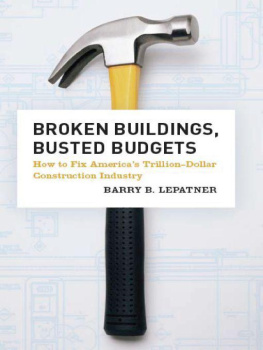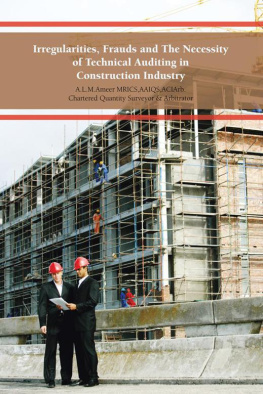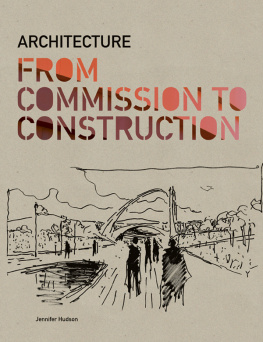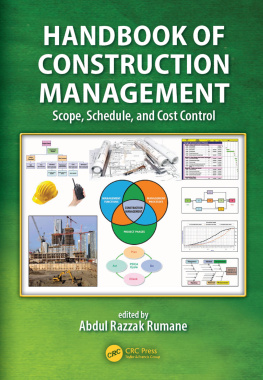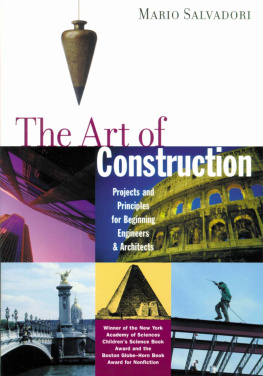Table of Contents
BARRY B. LEPATNER is founder and partner of LePatner and Associates LLP.
TIMOTHY JACOBSON is partner of Withrop Group.
ROBERT E. WRIGHT is clinical associate professor of economics at New York University.
The University of Chicago Press, Chicago 60637
The University of Chicago Press, Ltd., London
2007 by The University of Chicago
All rights reserved. Published 2007
Printed in the United States of America
16 15 14 13 12 11 10 09 08 07 1 2 3 4 5
ISBN-13: 978-0-226-47267-6 (cloth)
ISBN-10: 0-226-47267-1 (cloth)
Library of Congress Cataloging-in-Publication Data
LePatner, Barry B.
Broken buildings, busted budgets : how to fix Americas trillion-dollar construction industry / Barry B. LePatner, with Timothy Jacobson and Robert E. Wright.
p. cm.
Includes bibliographical references and index.
ISBN-13: 978-0-226-47267-6 (cloth : alk. paper)
ISBN-10: 0-226-47267-1 (cloth : alk. paper)
1. Construction industryUnited StatesHistory.
2. Construction industryUnited StatesManagement.
I. Jacobson, Timothy, C., 1948- II. Wright, Robert E. (Robert
Eric), 1969- III. Title.
HD9715.U52L46 2007
338.476900973dc22
2007019034
o The paper used in this publication meets the minimum requirements of the American National Standard for Information SciencesPermanence of Paper for Printed Library Materials, ANSI Z39.48-1992.
Imagine an automobile assembly line where each step along the line is undertaken by a different company with its own financial interest and separate labor union!... Present [construction] practice is impossible. The client asks an architect to design something specifically for him. In making drawings the architect will specify various components out of catalogues. He is nearly always restricted to elements that are already manufactured. Then the contractor, who has usually had nothing to do with the design process, examines the drawings and makes his bid. Industry supplies raw materials and components and has little contact with the contractor. The various building material manufacturers make their components totally independent of each other.... It is an absurd industry.
MOSHE SAFDIE, internationally renowned architect
Acknowledgments
This book is the product of several years of development and countless discussions with many in the industry who graciously shared their insights and experiences. As I began writing what would become Broken Buildings, Busted Budgets, I was fortunate to have associated with Timothy C. Jacobson and Robert E. Wright, historians and economists of note in their own right and my coauthors, who rigorously challenged my early assumptions and asked probing questions to lead us forward to more definitive answers. Working with them has been an intellectual challenge and broadened my own perspective on how the construction industry got into the shape it is in today.
I am blessed with partners and associates at LePatner & Associates LLP who are creative, analytic problem solvers. Through the many drafts of this book they contributed comments that framed my thinking and opened up new avenues to pursue. Their insights are embedded throughout. It would be remiss of me not to single out Brad Cronk who serves so admirably as our firms head of project management services. His comments and suggestions added immeasurably to the final editing process. Tadhg OConnor, my assistant and head of information technology, valiantly waded through numerous drafts of the book, always keeping everything where it was supposed to be.
When all was seemingly in place, the book benefited greatly from the insightful comments and restructuring put forth by David Pervin of the University of Chicago Press.
Finally, I cannot minimize the importance played by my three children. Instead of groaning that their father, who already had a full plate of commitments, was off on a new venture, each supported my efforts at every stage. Being with them has always been my greatest pleasure. Their backing for this work has been an enormous satisfaction.
Barry B. LePatner
May 2007, New York City
Introduction
How could a nation as technologically advanced and business oriented as this one care so little about how it spends upwards of $1 trillion on construction each year? All too frequently, construction projects of all sizes and types are plagued by massive cost increases that were totally unanticipated at the outset of the work. We have become almost immune to the fact that most construction in this nation will result in serious cost overruns and schedule delays. Executives of major U.S. corporations, the leaders of public institutions, and millions of American homeowners are routinely held hostage by the construction industry to pay up or face even greater costs and delays. All too often, corporate executives, who retain business advisors and consultants to oversee and coordinate every phase of their daily business activities, readily cede control to a construction manager with an overt conflict of interest in structuring the cost of a project. These realities have stymied me for many of the thirty plus years that I have served as construction counsel to real estate developers, national and international corporations, educational and healthcare institutions, and countless architects, engineers, and homeowners.
When questioned as to why they feel they have no control over what they spend for their hospital, school, or hotel project, business leaders express anger, frustration, or denial. Often few have any good answers to why it costs so much and takes so long. Yet runaway projects and pricing continue unabated. Whether a stadium for a football or baseball team, a new bridge or tunnel, or a hospital or school, all too often owners concede that neither the budget established by the contract nor the original scheduled completion date is under control. Knowledgeable construction executives, in defense, are quick to point out that each project is custom made, a veritable one off. When events miraculously transpire so that a project actually is completed on time and on budget, few clients can explain how this happy event occurs. In short, I came to realize that no one involved in the process has a clear understanding of why our nations construction world works the way it does.
It does not work like anything we are familiar with. When any of us go shopping for a car we make our decisions based on masses of information that enable us to compare models, options, pricing, and the like. The automobile industry spends hundreds of millions of dollars annually to convince us that their product is right for us. If they give us a fair representation of our expectations after we buy that Ford or Toyota, then the industry has a fair chance of securing the second part of their carefully orchestrated game plan: when it comes time for us to buy anew, we buy that next car from the same company. In a sense, the automobile industry, which is a very competitive industry, hopes to ensure our loyalty so that they do not need to compete for that second chance with each customer.
Not so the construction industry. While repeat business and reputation are important to most contractors, as to most businesses, the probability of a contractor getting a second and third project from a typical corporate, institutional, or individual owner is small. This is so for several reasons. To secure the initial project, a contractor is required to compete with many other contractors, some of whom may need the project more desperately than the others. Hence, the desperate contractors bid may be intentionally designed not to secure a known profit at the outset. Instead, it may be made with the strategy of getting the commission and then employing a number of tactics to create a profit during the course of the project. This is a major cause of the cost overruns, delays, and change orders that plague many owners.

